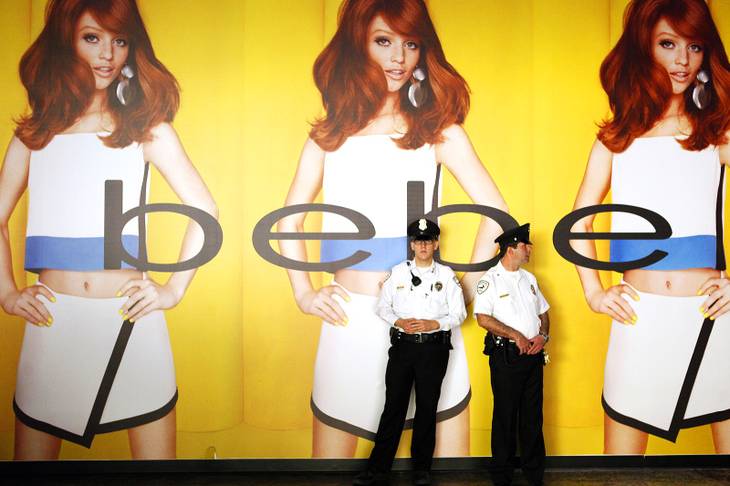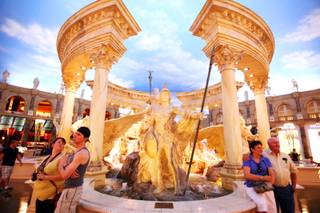When the Forum Shops at Caesars Palace opened 20 years ago, the high-end shopping center introduced a new level of luxury to the Strip.
Developers billed it “the shopping wonder of the world,” and at the time, it was. Nothing like it existed. Its marble walkways, designer stores and Strip-front, casino-adjacent location were all groundbreaking.
Two decades later, luxury shopping is the norm on the Strip. The Bellagio has its retail esplanade, Paris has Le Boulevard, and the Venetian and Palazzo both have high-end shopping malls off their casino floors. Multimillion-dollar remodeling projects at the Fashion Show mall and Miracle Mile Shops put those centers on par with their luxury neighbors.
The Strip is home to five Louis Vuitton stores, four Tiffany & Co. locations and three Jimmy Choo shops. And they’re all surviving.
A tumultuous economy has proven that even in tough times, Las Vegas’ four-mile Strip from Mandalay Bay to the Stratosphere can sustain the abundance of retail square footage it boasts.
“The great thing about Las Vegas and shopping is that there’s enough demand for everyone to be successful,” said Maureen Crampton, marketing director of the Forum Shops. “Because there are so many tourists, everyone has their own niche. We tend to complement each other.”
The Forum Shops consistently ranks first in the nation for revenue generated per square foot. There’s a years-long waiting list for space in the Venetian’s Grand Canal Shoppes. And the Miracle Mile Shops house several national chains that outperform every other franchise in their brand.
That isn’t to say shopping has been immune to the recession. Just like most businesses on the Strip and beyond, retail took a hit. Shopping centers that became accustomed to double-digit growth squeaked by with flat-line survival. Proprietors had to adapt.
They slowly embraced a new model, one that local governments and casinos began to notice. Diversity is key. And so H&Ms started moving in next to Chanels.
“On the Strip, you see value-oriented uses popping up where you wouldn’t see them normally,” said Russ Joyner, general manager of the Miracle Mile Shops. “Retailers are adapting to the customer’s need. Luxury is still a valid and critical component of the mix that’s offered here; it just seems like now less is more.”
The mall now known as the Miracle Mile Shops opened in 2000 as Desert Passage, a high-end center with a Moroccan theme. It struggled.
“The trend in town was who can do high-end best, and Desert Passage aspired, unsuccessfully, to that,” Joyner said.
Bankruptcy at the adjoining Aladdin, and that resort’s appeal to a more budget audience, didn’t help.
“Our philosophy as we introduced the Miracle Mile Shops in 2007 was to try to do the moderate concept and do it well,” Joyner said. “The ones who do luxury do it right and have that base covered. The emphasis now is on the more affordable and the trendy.”
The shift worked. Since late 2009, the Miracle Mile Shops have seen nine consecutive quarters of double-digit sales and traffic growth, an admirable accomplishment even in flush times. About 80,000 people visit the mall per day. The center’s Frederick’s of Hollywood is ranked first in sales within its 175-store chain, and the mall’s Ultra Diamonds outpaces all others in its 165-store franchise.
Likewise, the Forum Shops leads the nation in generating revenue, and has for most of its existence. The typical U.S. mall nets close to $400 a square foot. Tenants in the Forum Shops generate three to four times that.
When the center opened in 1992, it was an unknown entity. Skeptics said a themed shopping mall next to a casino on Las Vegas Boulevard would never work. Twenty years and two expansions later, it comprises almost 700,000 square feet. Crampton recalls the early years of retailers running out of merchandise because they underestimated the center’s success.
Close to 80 percent of customers at the Forum Shops, and most malls on the Strip, are tourists. Of those, almost half are international. Surveys conducted by the Las Vegas Convention and Visitors Authority show that shopping is one of the top reasons people visit Las Vegas.
“In the beginning, we brought in luxury because we wanted to bring something to the table that wasn’t offered,” Crampton said. “The international customer, especially the Asian market, is brand savvy. They don’t buy one; they buy five. It’s not seasonal; it’s quality for life. They want to give a gift related to quality because their reputation lies on it.”
But Crampton said variety is vital — both in products and prices.
"If you are traveling, you might need a T-shirt, some jeans,” she said. “We knew we had to balance it out. Not everyone shops at Louis Vuitton, but not everyone shops at the Gap either.”
The Forum Shops is now home to the world’s largest H&M store. Mid-level retailers such as Express, Skechers and Nike join original tenants Gucci, Versace and St. John.
The story is the same at the Grand Canal Shoppes, Fashion Show mall and other Strip centers.
“Making the shopping center approachable, and a purchase attainable, is part of the magic of our success,” Crampton said. “You might not be able to dine at Spago, but you can grab a gelato at the bar at Trevi.”


